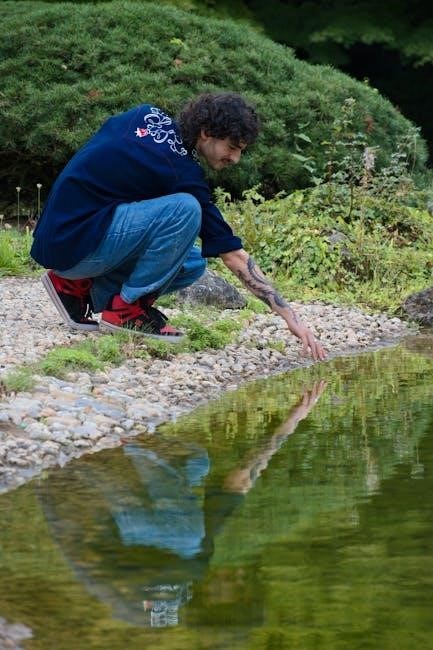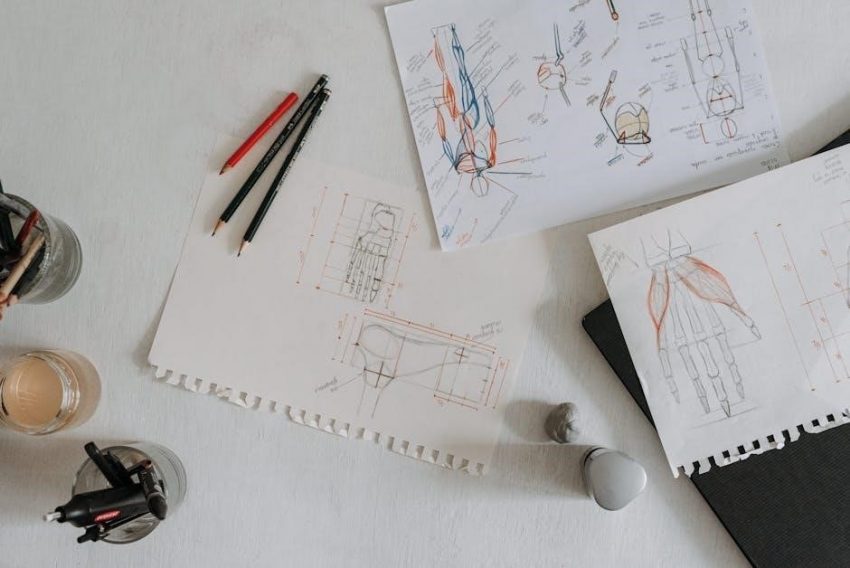Anatomy and physiology form the cornerstone of understanding the human body’s structure and function. Laboratory exploration provides hands-on experience, linking theoretical knowledge to practical observations. Through microscopy, dissection, and physiological measurements, students gain insights into cellular, tissue, and organ systems, fostering a deeper appreciation of human biology. This foundational understanding is essential for careers in healthcare, research, and related fields, emphasizing the importance of laboratory-based learning in bridging the gap between textbooks and real-world applications.
1.1 Basic Concepts and Terminology
Understanding basic anatomical and physiological concepts is essential for laboratory exploration. Key terms include directional terms like anterior, posterior, dorsal, and ventral, which describe body orientations. Body planes, such as sagittal, frontal, and transverse, help visualize sections of the body. Additionally, knowledge of body cavities (e.g., thoracic and abdominal) and organ systems (e.g., skeletal, muscular, and nervous) forms the foundation of A&P studies. These concepts enable students to communicate effectively and accurately describe structures and processes. Laboratory activities, such as identifying tissues under a microscope or dissecting specimens, reinforce these terms, ensuring a strong grasp of fundamental principles. Mastery of this terminology is critical for success in both theoretical and practical aspects of anatomy and physiology.
1.2 The Role of Laboratory Exploration in Learning
Laboratory exploration is a vital component of learning anatomy and physiology, offering hands-on experience that complements theoretical knowledge. Labs provide opportunities for students to observe and interact with biological structures, enhancing understanding of complex concepts. Activities such as microscopy, dissection, and physiological measurements allow direct observation of tissues, organs, and systems, reinforcing textbook content. This practical approach engages students actively, making learning more interactive and enjoyable. Moreover, labs foster the development of scientific and analytical skills through experiments and data interpretation. Collaborative learning in lab settings also promotes teamwork and communication. By applying theoretical knowledge in real-world scenarios, students gain confidence and a deeper appreciation for human biology, preparing them for future careers in healthcare and research.
1.3 The Connection Between Anatomy and Physiology
Anatomy and physiology are deeply interconnected, with anatomy focusing on the structure of body parts and physiology on their functions. Understanding anatomy provides the foundation for comprehending physiological processes, as structure often dictates function. For instance, the microscopic structure of cells influences their physiological roles. Conversely, physiological processes shape anatomical structures over time. This interdependence is crucial in fields like medicine, where diagnosing and treating conditions require knowledge of both. Laboratory exploration enhances this understanding by allowing students to observe anatomical structures and their physiological functions firsthand. This integrated approach fosters a holistic view of the human body, enabling students to appreciate how systems interact and maintain homeostasis. By studying anatomy and physiology together, learners gain a comprehensive understanding of human biology, essential for advancing in healthcare and scientific research.

Importance of Laboratory Work in A&P
Laboratory work in anatomy and physiology bridges theoretical knowledge with practical application, enabling students to explore anatomical structures and physiological processes hands-on. This experiential learning enhances understanding, critical thinking, and problem-solving skills, preparing students for healthcare and scientific careers.
2.1 Hands-On Learning and Practical Application
Laboratory work in anatomy and physiology emphasizes hands-on learning, allowing students to directly observe and interact with anatomical structures. Practical exercises, such as microscopy and dissection, provide tangible experiences that reinforce theoretical concepts. By engaging with specimens and conducting physiological measurements, students develop a deeper understanding of how body systems function. This active learning approach enhances retention and fosters critical thinking, enabling students to apply knowledge in real-world scenarios. Hands-on activities also cultivate essential scientific and analytical skills, preparing learners for careers in healthcare and research. The integration of laboratory exploration with classroom instruction creates a comprehensive learning environment, ensuring students are well-equipped to tackle complex challenges in the field.
2.2 Applying Theoretical Knowledge in Real-World Scenarios
Laboratory exercises in anatomy and physiology enable students to apply theoretical concepts to real-world scenarios, enhancing their ability to connect classroom learning with practical applications. For instance, understanding directional terms and body planes is crucial for interpreting medical imaging, while knowledge of organ systems is vital for diagnosing and treating conditions. Practical tasks, such as identifying tissues under a microscope or analyzing physiological data, simulate clinical environments, preparing students for careers in healthcare. This application of theoretical knowledge fosters problem-solving skills and adaptability, essential for addressing complex medical challenges. By bridging the gap between theory and practice, laboratory work ensures students are equipped to apply their understanding in meaningful, real-world contexts, from patient care to scientific research.
2.3 Developing Scientific and Analytical Skills
Laboratory work in anatomy and physiology fosters the development of scientific and analytical skills through hands-on exploration and data interpretation. Students learn to observe, measure, and analyze physiological processes, such as heart rate and blood pressure, using specialized tools. These exercises enhance critical thinking and problem-solving abilities, as students interpret data to draw conclusions about bodily functions. Additionally, activities like microscopic analysis and tissue identification refine attention to detail and observational skills. Engaging with laboratory materials, such as digital tools and multimedia resources, further strengthens analytical capabilities. By applying scientific methods to real-world biological questions, students develop a systematic approach to learning, preparing them for careers in healthcare, research, and related fields. These skills are essential for understanding complex biological systems and addressing scientific challenges effectively.

Structure of a Typical A&P Lab Manual
A typical A&P lab manual includes organized content, visual aids, and activities to enhance learning. It provides structured exercises, illustrations, and guided explanations to support hands-on exploration and understanding.
3.1 Organization and Content Layout
A typical A&P lab manual is meticulously organized to facilitate effective learning. It begins with foundational concepts, such as directional terms and body planes, progressing logically to more complex systems. Each chapter is structured to align with course objectives, ensuring a coherent flow of information. Visual aids like diagrams, photographs, and illustrations are integral to the layout, helping students visualize anatomical structures. The content is divided into clear sections, including materials, procedures, and expected outcomes, making it easy for students to follow. Additionally, the manual often includes appendices with anatomical terminology and safety protocols, serving as a comprehensive reference. This systematic approach ensures that students can navigate the material confidently, reinforcing their understanding of anatomy and physiology through practical exploration.
3.2 Use of Visual Aids and Multimedia Resources
Visual aids and multimedia resources are essential components of modern A&P lab manuals, enhancing student engagement and understanding. High-quality illustrations, photographs, and micrographs help students identify anatomical structures and cellular details. Digital tools, such as 3D models and virtual simulations, allow interactive exploration of complex systems. Videos and animations demonstrate dynamic physiological processes, making abstract concepts more tangible. These resources also include labeled diagrams and comparative images to aid in differentiation between similar structures. Additionally, multimedia resources like audio explanations and interactive quizzes reinforce learning. The integration of these visual elements ensures that students can visualize and internalize anatomical and physiological information effectively, bridging the gap between theoretical knowledge and practical application.

3.3 Engaging Activities and Exercises for Students
Engaging activities and exercises are crucial for fostering active learning in A&P labs. These include hands-on tasks like identifying anatomical structures in images, matching terms with definitions, and solving case studies. Interactive group work encourages collaboration, while problem-solving exercises enhance critical thinking. Technology-integrated activities, such as virtual labeling and 3D model exploration, provide immersive learning experiences. Flashcards, quizzes, and games make complex concepts more approachable and fun. These activities not only improve retention but also help students apply theoretical knowledge in practical scenarios. By incorporating a variety of exercises, lab manuals ensure that students remain motivated and engaged, ultimately deepening their understanding of anatomy and physiology. Such interactive approaches are vital for developing both conceptual knowledge and practical skills in A&P education.

Key Laboratory Exercises in A&P
Key lab exercises include microscopic anatomy, organ dissection, and physiological measurements, providing hands-on exploration of cells, tissues, and organ systems, enhancing practical understanding of human biology.
4.1 Microscopic Anatomy and Cell Identification
Microscopic anatomy involves the study of cellular structures and tissues under magnification, enabling students to identify and differentiate various cell types and their organizations. This exercise is fundamental for understanding the building blocks of life and how they contribute to overall bodily functions. Through hands-on activities, students learn to prepare and examine slides, using staining techniques to enhance visibility of cellular details. Identifying key features such as cell shape, size, and organelles helps in recognizing specialized cells like neurons, muscle fibers, and epithelial cells. This lab work bridges the gap between theoretical knowledge and practical observation, fostering a deeper understanding of tissue classification and histology. Such skills are essential for diagnosing diseases and comprehending pathological processes, making microscopic anatomy a cornerstone of A&P laboratory education.
4.2 Organ Dissection and Tissue Analysis
Organ dissection and tissue analysis are critical components of A&P lab work, allowing students to explore the structural and functional relationships within organs. By examining tissues under magnification, students identify histological features and classify tissue types. Dissection provides hands-on experience with organ morphology, enhancing understanding of how organs contribute to system-level functions. Activities include identifying anatomical landmarks and correlating tissue structure with physiological roles. These exercises refine precision and observational skills, preparing students for careers requiring detailed anatomical knowledge. Through practical exploration, students bridge theoretical concepts with tangible observations, gaining a deeper appreciation of organ systems’ complexity and interdependence. This lab work is indispensable for developing a comprehensive understanding of human anatomy and its applications in medicine and research.
4.3 Physiological Measurements and Data Analysis
Physiological measurements and data analysis are essential lab exercises that enable students to investigate bodily functions in real-time. Techniques include measuring heart rate, blood pressure, and respiratory rate using tools like ECG, spirometry, and plethysmography. These activities allow students to observe how physiological variables change under different conditions, such as exercise or stress. Data analysis involves interpreting collected information, often using software to visualize and compare results. These exercises enhance understanding of physiological principles, such as homeostasis and reflex mechanisms. By analyzing data, students develop critical thinking and problem-solving skills, fostering a deeper connection between theoretical concepts and practical observations. Such hands-on experiences prepare students for real-world applications in healthcare and research, emphasizing the importance of accurate measurement and interpretation in physiological studies.

Role of Technology in A&P Laboratories
Technology has revolutionized anatomy and physiology labs through digital tools, virtual simulations, and 3D models, enabling interactive exploration of complex structures and enhancing student engagement and understanding.

5.1 Digital Anatomy Tools and Software
Digital anatomy tools and software have transformed laboratory learning by providing interactive 3D models, virtual dissections, and real-time manipulation of anatomical structures. These tools allow students to explore complex anatomical relationships in detail, enhancing their understanding of spatial arrangements and functional anatomy. Software such as digital anatomy platforms enables users to peel away layers of tissue, visualize systems in isolation, and compare healthy and diseased states. Integrating these tools with lab manuals creates a hybrid learning environment, blending traditional methods with modern technology. Studies highlight improved engagement and retention rates among students using digital anatomy tools, as they offer self-paced learning and personalized exploration. This technological advancement not only supplements lab work but also prepares students for future clinical applications, making it an indispensable resource in anatomy and physiology education.
5.2 Virtual Simulations and 3D Models
Virtual simulations and 3D models have revolutionized anatomy and physiology education by providing immersive, interactive learning experiences. These tools enable students to explore complex anatomical structures in detail, allowing for a deeper understanding of spatial relationships and functional processes. Virtual simulations mimic real-world scenarios, such as surgical procedures or physiological events, enabling students to practice and observe outcomes in a controlled environment. 3D models offer the ability to manipulate and rotate structures, enhancing visual learning and retention. These resources are particularly valuable for visual learners and complement traditional lab work by offering anytime, anywhere access to anatomical exploration. By integrating virtual simulations and 3D models, educators create engaging, personalized learning experiences that cater to diverse student needs and enhance overall comprehension of anatomy and physiology concepts.
5.3 Virtual Dissection and Exploration
Virtual dissection and exploration tools offer students the ability to examine anatomical structures in unprecedented detail without the need for physical specimens. These digital platforms allow users to peel back layers of tissue, explore internal organs, and visualize complex systems in three dimensions. Virtual dissection enhances learning by providing a safe, ethical, and repeatable environment for students to practice and reinforce their understanding of anatomy. Additionally, these tools often include interactive labels, measurements, and real-time simulations, making them invaluable for both individual study and classroom instruction. By leveraging virtual dissection, educators can create engaging, modern learning experiences that cater to diverse learning styles and enhance the retention of anatomical knowledge. This technology is particularly beneficial for visual learners, as it provides a dynamic and immersive way to explore the human body.

Common Challenges in A&P Lab Work
Common challenges include specimen preparation difficulties, maintaining safety protocols, and addressing knowledge gaps, all requiring careful management to ensure effective learning and student safety.
6.1 Specimen Preparation and Maintenance
Specimen preparation and maintenance are critical in A&P lab work, requiring precision and care to preserve anatomical integrity. Proper cleaning, storage, and handling ensure specimens remain usable for extended periods. Challenges include degradation, contamination, and structural damage, which can hinder educational value. Techniques like fixation and preservation are essential to maintain specimen quality. Additionally, proper labeling and organization prevent mix-ups, ensuring accurate identification during lab sessions. Students must adhere to protocols to avoid errors, as improper preparation can lead to misleading observations. Regular maintenance also involves monitoring storage conditions to prevent deterioration. Effective specimen management enhances learning outcomes by providing high-quality materials for hands-on exploration and analysis, making it a cornerstone of successful A&P laboratory experiences.
6.2 Safety Protocols and Biohazard Management
Safety protocols and biohazard management are paramount in A&P laboratories to protect students and staff from potential hazards. Proper handling of biological specimens, chemicals, and sharp instruments is essential to prevent accidents and exposure to pathogens. Personal protective equipment (PPE), including gloves and goggles, must be worn to minimize risks. Waste disposal protocols ensure biohazardous materials are handled and stored safely, adhering to regulatory standards. Emergency procedures, such as spill kits and first aid, are critical for prompt responses to incidents. Regular training and compliance with safety guidelines foster a secure learning environment, emphasizing the importance of vigilance and adherence to best practices in maintaining laboratory safety and preventing biohazard-related incidents.
6.3 Bridging Knowledge Gaps and Learning Difficulties
Bridging knowledge gaps and addressing learning difficulties are critical in A&P lab work, as students often struggle with complex concepts and practical applications. Pre-lab preparation, guided explanations, and interactive activities help students connect theoretical knowledge with hands-on experiences. Encouraging active participation, collaboration, and peer-to-peer learning fosters a supportive environment for overcoming challenges. Utilizing reference materials, such as lab manuals and digital tools, provides additional resources for clarification and review. Instructors play a key role in identifying knowledge gaps and tailoring instruction to individual needs, ensuring students grasp foundational concepts before advancing. Addressing learning difficulties early enhances overall understanding and confidence, making laboratory exploration more effective and engaging for students at all skill levels.

Best Practices for Students in A&P Labs
Students should prepare thoroughly for lab sessions, engage actively in hands-on activities, and collaborate with peers to enhance learning. Utilizing reference materials and digital tools effectively supports understanding and retention of complex concepts, fostering success in anatomy and physiology studies.
7.1 Preparing for Lab Sessions Effectively
Effective preparation for A&P lab sessions involves reviewing assigned materials, understanding key terminology, and organizing lab tools. Students should preview laboratory exercises, familiarize themselves with directional terms, body planes, and organ systems. Engaging with digital resources, such as flashcards and interactive models, enhances readiness. Practicing microscopic anatomy and specimen identification beforehand also improves efficiency during lab time. By organizing notes and questions, students can maximize their learning experience, ensuring they are well-equipped to participate actively in hands-on activities and discussions.
7.2 Active Participation and Collaboration
Active participation and collaboration are vital for maximizing learning in A&P lab sessions. Engaging in group activities encourages shared understanding, as students discuss and explain concepts to one another. Collaborative exercises, such as organ dissection and physiological measurements, foster teamwork and practical application of knowledge. Guided explanations from instructors and peers enhance comprehension, while interactive tools like digital anatomy software promote collective exploration. Actively contributing to discussions and activities ensures students remain focused and invested in their learning. This collaborative environment also prepares students for real-world scenarios, where teamwork is essential in healthcare and scientific fields. By actively participating, students not only deepen their understanding but also develop essential communication and problem-solving skills.
7.3 Utilizing Available Resources and References
Utilizing available resources and references is crucial for success in A&P lab work. Lab manuals, such as Exploring Anatomy & Physiology in the Laboratory, provide detailed activities and visual aids to enhance learning. Digital anatomy tools, like 3D models and virtual simulations, offer interactive exploration of complex structures. Textbooks, online platforms, and flashcards are valuable for reinforcing theoretical knowledge. Additionally, instructors often provide supplementary materials, such as guided explanations and study guides, to aid comprehension. Students should actively consult these resources to clarify doubts and deepen their understanding. Regularly reviewing lecture notes and lab materials ensures better retention of concepts. By leveraging these resources, students can effectively prepare for lab sessions, engage in active learning, and achieve better academic outcomes in anatomy and physiology courses.

The Future of A&P Laboratory Education
Advancements in digital anatomy tools and virtual simulations are revolutionizing A&P education, offering immersive, personalized learning experiences that enhance engagement and understanding of complex biological structures and processes.
8.1 Advancements in Digital Learning Tools
The integration of digital anatomy tools and software has transformed A&P laboratory education, offering immersive and interactive learning experiences. These tools, such as 3D models and virtual dissection platforms, enable students to explore complex anatomical structures in detail, fostering deeper understanding and engagement. Virtual simulations and multimedia resources, as highlighted in studies by K. Finn and others, provide real-time feedback and self-paced learning opportunities, catering to diverse learning styles. Additionally, these tools enhance collaboration among students and instructors, creating a dynamic and inclusive educational environment. The seamless integration of digital learning tools with traditional laboratory methods ensures a comprehensive learning experience, preparing students for future advancements in healthcare and scientific research. These innovations underscore the growing importance of technology in modern A&P education.
8.2 Integration of Emerging Technologies
The integration of emerging technologies, such as virtual and augmented reality (VR/AR), artificial intelligence (AI), and machine learning, is revolutionizing A&P laboratory education. These technologies provide immersive, interactive, and personalized learning experiences, enabling students to explore anatomical structures and physiological processes in unprecedented detail. For instance, VR simulations allow students to visualize complex systems like the circulatory or nervous system in 3D, enhancing comprehension and retention. AI-driven tools, such as adaptive learning platforms, tailor exercises to individual student needs, while machine learning algorithms analyze data to provide real-time feedback. These advancements not only enhance engagement but also bridge gaps in understanding, offering a more dynamic and effective approach to A&P learning. The integration of such technologies ensures that laboratory education remains cutting-edge and aligned with the demands of modern healthcare and scientific research.
8.3 Personalized Learning Experiences
Personalized learning experiences in A&P laboratory education are transforming how students engage with complex biological concepts. By leveraging emerging technologies, such as adaptive learning software and 3D modeling tools, labs can now cater to individual student needs. These tools allow for customized learning paths, enabling students to focus on areas where they need improvement while accelerating through familiar topics. Interactive simulations and virtual labs further enhance this personalization, providing real-time feedback and allowing students to explore anatomical structures at their own pace. Additionally, data analytics from these tools help instructors identify knowledge gaps and tailor teaching strategies. This approach not only improves learning outcomes but also fosters a more inclusive and effective educational environment, ensuring that each student achieves their full potential in understanding anatomy and physiology.
